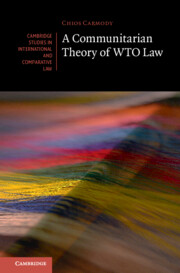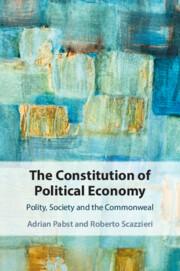Refine search
Actions for selected content:
76 results
Part II - Lenses and Lessons
-
- Book:
- Learning through Social Work Stories-That-Matter
- Published online:
- 28 August 2025
- Print publication:
- 11 September 2025, pp 311-364
-
- Chapter
- Export citation
Decomposing Network Influence: Social Influence Regression
-
- Journal:
- Political Analysis , First View
- Published online by Cambridge University Press:
- 27 August 2025, pp. 1-20
-
- Article
-
- You have access
- Open access
- HTML
- Export citation
INTRODUCTION: THE CONSTITUTION OF POLITICAL ECONOMY
-
- Journal:
- National Institute Economic Review ,
- Published online by Cambridge University Press:
- 20 August 2025, pp. 1-4
-
- Article
-
- You have access
- Open access
- HTML
- Export citation
Chapter 7 - Vulnerability, Dialogue, and the Limits of Autonomy
- from Part IV - The Limits of Autonomy and Self-Rule
-
-
- Book:
- Platonic Autonomy
- Published online:
- 07 August 2025
- Print publication:
- 31 July 2025, pp 149-168
-
- Chapter
- Export citation
Digital Interdependence and Power Politics
-
- Journal:
- British Journal of Political Science / Volume 55 / 2025
- Published online by Cambridge University Press:
- 14 July 2025, e93
-
- Article
-
- You have access
- Open access
- HTML
- Export citation
9 - Distance
- from Part III - Configurations and Telos
-
-
- Book:
- Rethinking Global History
- Published online:
- 14 November 2024
- Print publication:
- 21 November 2024, pp 210-234
-
- Chapter
-
- You have access
- Open access
- HTML
- Export citation
3 - The Strategic Life of Peripheral-Patronage States
-
- Book:
- Power, Patronage and International Norms
- Published online:
- 01 November 2024
- Print publication:
- 13 June 2024, pp 40-79
-
- Chapter
- Export citation
13 - Postscript
-
-
- Book:
- Social Justice in Twentieth-Century Europe
- Published online:
- 29 February 2024
- Print publication:
- 07 March 2024, pp 267-272
-
- Chapter
- Export citation
2 - The WTO Agreement as Community
-
- Book:
- A Communitarian Theory of WTO Law
- Published online:
- 14 December 2023
- Print publication:
- 21 December 2023, pp 55-107
-
- Chapter
- Export citation
1 - A Theory of WTO Law
-
- Book:
- A Communitarian Theory of WTO Law
- Published online:
- 14 December 2023
- Print publication:
- 21 December 2023, pp 1-54
-
- Chapter
- Export citation

A Communitarian Theory of WTO Law
-
- Published online:
- 14 December 2023
- Print publication:
- 21 December 2023
18 - States are Saying Farewell to Wars
-
- Book:
- A Farewell to Wars
- Published online:
- 09 November 2023
- Print publication:
- 23 November 2023, pp 270-296
-
- Chapter
- Export citation
6 - Overview of Disincentives to and Restraints on the Interstate Use of Force
-
- Book:
- A Farewell to Wars
- Published online:
- 09 November 2023
- Print publication:
- 23 November 2023, pp 107-115
-
- Chapter
- Export citation
3 - The Case for Collaboration
- from Part I - Institutions and Interactions
-
- Book:
- The Collaborative Constitution
- Published online:
- 12 October 2023
- Print publication:
- 26 October 2023, pp 86-118
-
- Chapter
- Export citation
1 - The Scientific Study of Relationships
- from Part I - Foundational Ideas of Relationship Science
-
- Book:
- The Science of Romantic Relationships
- Published online:
- 17 August 2023
- Print publication:
- 31 August 2023, pp 3-41
-
- Chapter
- Export citation
Some differences, many similarities: comparing Europe’s responses to the 1973 oil crisis and the 2022 gas crisis
-
- Journal:
- European Political Science Review / Volume 16 / Issue 1 / February 2024
- Published online by Cambridge University Press:
- 22 August 2023, pp. 56-71
-
- Article
-
- You have access
- Open access
- HTML
- Export citation
4 - Article 12 and Autonomy
-
- Book:
- Mental Capacity, Dignity and the Power of International Human Rights
- Published online:
- 03 August 2023
- Print publication:
- 17 August 2023, pp 112-150
-
- Chapter
- Export citation
5 - Article 12 and Dignity
-
- Book:
- Mental Capacity, Dignity and the Power of International Human Rights
- Published online:
- 03 August 2023
- Print publication:
- 17 August 2023, pp 151-195
-
- Chapter
- Export citation
3 - The Principle of Indivisibility and Article 12
-
- Book:
- Mental Capacity, Dignity and the Power of International Human Rights
- Published online:
- 03 August 2023
- Print publication:
- 17 August 2023, pp 74-111
-
- Chapter
- Export citation

The Constitution of Political Economy
- Polity, Society and the Commonweal
-
- Published online:
- 03 August 2023
- Print publication:
- 17 August 2023

